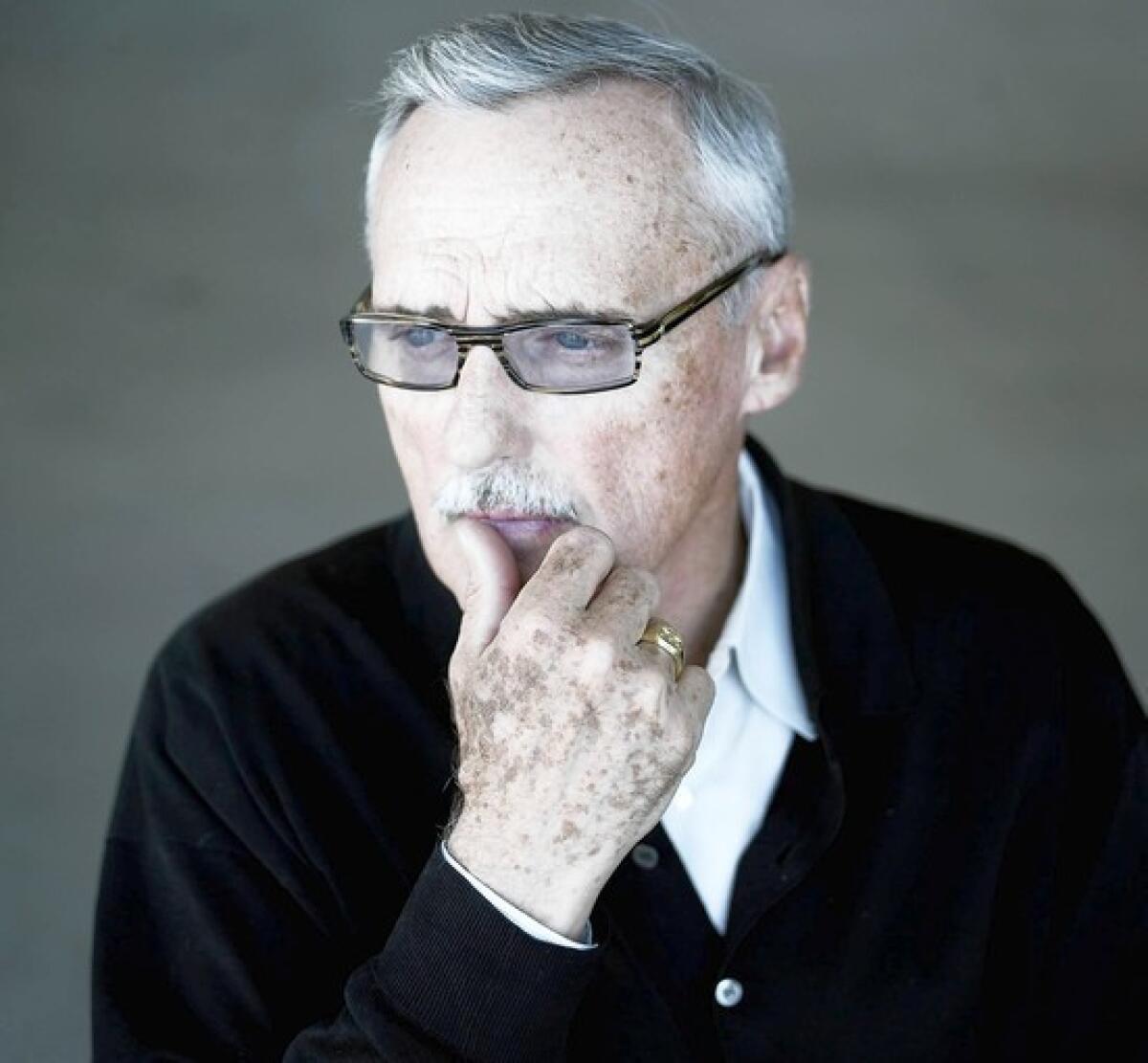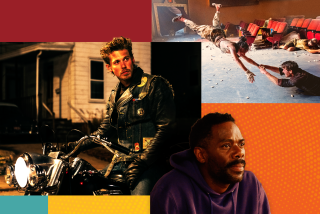Dennis Hopper’s carnival ride through life

- Share via
“I was a beatnik, and then I was a hippie, and before that I was a bohemian,” a sky-high Dennis Hopper confided to Merv Griffin on television one night in 1971, in a clip you can see on YouTube. On the opposite couch, Willie Mays uncomfortably refilled his glass of water and James Brolin sneered — Hopper certainly didn’t belong to their worlds.
But “San Francisco Giants legends” and “future husbands of Barbra Streisand” might be among the few groups in which Dennis Hopper could not claim membership. In fact, Hopper was underselling his zeitgeist bona fides to Merv: By the time he was 30, he’d also toiled under the Old Hollywood studio system, studied the Method, kibitzed with jazzbos in New York, chronicled the burgeoning Pop Art scene (and the civil rights movement and Tijuana bullfighting) in black-and-white Tri-X, starred in low-budget independent films and partied with the San Francisco Mime Troupe.
Hopper, who died in 2010, is best remembered today for variations on a few wild-eyed characters — the twitchy sidekick in “Easy Rider,” the gesticulating photojournalist in “Apocalypse Now,” the gas-huffing madman in “Blue Velvet” — but one could take away his entire acting career and still leave a towering figure in 20th century culture.
Hopper’s outsized, often unhinged life is ready-made for mythologizing, and Tom Folsom’s boisterous new biography, “Hopper,” never misses an opportunity to imagine it in cinematic terms.
Much as Oliver Stone seized on Jim Morrison’s peyote vision quests in “The Doors,” Folsom opens with a dreamy vignette imagining Hopper on an epic motorcycle journey and throughout the narrative makes associative leaps that tumble across guest star-packed decades: We see Hopper as a teenage contract player at Warner Bros., nipping at the heels of mentor and costar James Dean, planning Champagne-bath orgies with Natalie Wood and giving acting tips to a young Elvis Presley; as a precocious art collector, cramming a house with early Warhols and Rauschenbergs and Ruschas; as a photographer, who earned the nickname “The Tourist” for the Nikon permanently slung around his neck. (Many of his astonishing portraits, including of Paul Newman and Ed Ruscha, are presented in Prestel’s recent coffee table book “Dennis Hopper: The Lost Album.”)
We also see Hopper as a stubborn filmmaker who was every bit as controlling as the old-timers he’d bristled under. His debut film as a director, “Easy Rider,” was the fulcrum on which his life pivoted and a time capsule that perhaps sealed its maker in with it — the utterance of the title would henceforth conjure thoughts of the Vietnam Generation, customized Harley-Davidsons and Steppenwolf songs but rarely spark discussion about the way Hopper borrowed from Bruce Conner shorts or collided Pop sensibilities with middle American roadside vistas as only a Kansas farm boy by way of L.A. could.
An emboldened Hopper put all his chips on the willfully elliptical follow-up, “The Last Movie,” filmed on location under legendarily hedonistic conditions in the mountains of Peru; with the 40 hours of footage, he retired to Taos, N.M., where he purchased an old movie theater, brandished shotguns and racked up misdemeanors. The sublime and maddening “Last Movie” was a bomb, and Hopper’s name became synonymous with “counterculture casualty.”
By the early 1980s, he was literally dynamiting himself (as a drunken stunt at a Houston speedway) and wandering naked into the jungles of Mexico, believing himself to be “a galaxy” (authorities found him masturbating on a tree and airlifted him out of the country).
Hopper’s career finally recovered in the middle of the decade, and although he was afforded much respect as an icon of rebelliousness, the public seldom recognized him for his achievements outside of acting — an irony that grew only richer with every role in a “Waterworld” or a “Super Mario Bros.”
There’s seemingly no limit to the anecdotal gold to be mined from Hopper’s carnival of a life; the cruel twist is that it threatens to crowd out the private soul of the man at the center, turning him into a Leonard Zelig with a temper and a stash. Hopper’s willingness to indulge tall tales throughout his life combines with the book’s lack of source citations to blur the lines of breathless embellishment, but among the most valuable moments are those when Hopper is gifted with quiet reflection, usually about actorly insecurities.
Folsom (also author of “The Mad Ones,” a biography of mobster Joe Gallo) mostly rides along on high-octane New Journalism prose, mixing onomatopoeia and jiving patois with lots of italics, man, which just might be the kind of biography that the fast-talking Hopper would have envisioned for himself.
He certainly cultivated the image of a “walking contradiction” (as Kris Kristofferson called him in song), a savant aesthete who claimed he never read books but learned everything at the Museum of Modern Art. It’s the kind of bluster that’s perfect for a myth. But watch Dennis Hopper sitting on Merv Griffin’s couch, lamenting the commercial failure of “The Last Movie,” and you’ll see a sadness and desperation and determination — a humanity — that has never quite made it to the page.
Howe is the author of “Marvel Comics: The Untold Story.”
Hopper
A Journey Into the American Dream
Tom Folsom
It Books: 320 pp., $26.99
More to Read
Sign up for our Book Club newsletter
Get the latest news, events and more from the Los Angeles Times Book Club, and help us get L.A. reading and talking.
You may occasionally receive promotional content from the Los Angeles Times.







